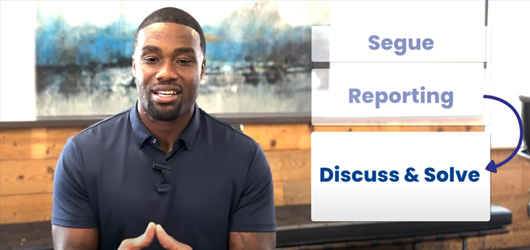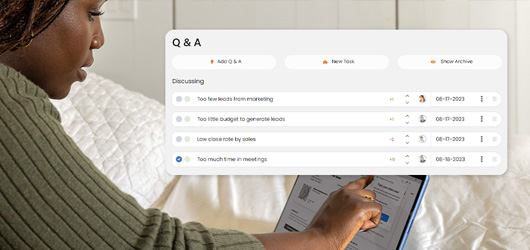Highly Productive Meetings
When was the last time you had a really productive meeting? It's probably been a while.

Usually, meetings are painfully unorganized, with the wrong people in the room and no clear action at the end. Basically, they're a waste of your time. At our company, we teach how to hold world-class meetings, something we call a "highly productive meeting."
We call it a highly productive meeting because after each meeting, we ask the team to rate its effectiveness between 1 and 10. The typical meeting you suffer through averages a rating of about 4. But we'll show you how to raise all your meetings to a rating of 10. Highly productive meetings are so effective because they're a time management tool. They make the most of you and your team coming together for those precious minutes.
A highly productive meeting has 4 key points. It needs to be on the same day at the same time and use the same agenda. It has to start on time and end on time—if not early. Now, let's go through the methodology of a highly productive meeting.
The Segue
First, the meeting starts on time. Once everyone is settled, the meeting leader initiates the meeting by saying, "Okay, everyone, let's segue," signaling we're going to transition from the tactical work in the business to the strategic work on the business. The segue should be rapid-fire sharing around the table and only last about five minutes. It adds a human touch and helps set a positive mood to the meeting.
As coach Vince Lombardi used to say, early is on time, and on time is late.
Reporting
After the segue, the meeting moves into reporting mode. The methodology here is you're now making sure everything important in your business is on track. You're checking if the numbers are on track, if your priorities are correct, and your people are happy.
There's no explaining, just on track or off track, looks right or looks off. Then, you're going to do a priority review to make sure the priorities are still set appropriately.
Remember, we're in reporting mode. Any number that's off track, any task that's late, any priority that's miss-aligned, anything that requires discussion or is an issue that needs to be solved, you simply drop them down to your Q&A list.
During this reporting mode, the idea is ZERO discussion. You're not solving anything; you're just reporting for 15 quick minutes and building our Q&A list.
Discuss & Solve
Q&A are the question-and-answer session where we address questions and issues raised during reporting or prior to the start of this meeting. Prioritize which Q&As your going to discuss. Which does the group agree are the most important questions or issues to address? Tackle them in order of priority. Never start at the top and work your way down; always go in order of priority.
Then, start with the number one, most important Q&A. Identify what the real question or issue is. Before you start solving anything, this is vital. The group needs to agree on what the real question or issue is, and sometimes you have to dig deep down to the root cause of that question or issue to get to it.
Once you've discovered the real question or issue, you move to discuss it. This is where you and your team openly and honestly discuss the question or issue. You cover every option, every solution, and every idea. Then, you push to solve it. The only reason you're talking in this portion is to solve questions or issues.
Typically, as part of solving the question or issue, you need to create one or more tasks to be completed in the next week. Tasks are usually seven-day action items, so the tasks for that item need to get done in the next seven days. After you solve the first item, it falls off the list and you move to the next in your prioritized list. And so on for the lion's share of the meeting time.
Here's the thing: Some weeks you only get through one Q&A, and other weeks you'll get through 10. You never know. But as long as you're taking them in order of priority, you're doing the right thing. Once there are five minutes left in the meeting, let's wrap-up. That means wherever you are in addressing the Q&A, you start to conclude.
Wrap-Up
With five minutes left, it's time to wrap up, so you do three quick things: first, make sure everybody understands the tasks assigned to them from the meeting. Second, discuss if there are any cascading messages that need to be communicated to the rest of the organization. Lastly, quickly rate your meeting on a scale of 1 to 10, with 10 being the best. Rating the meeting will help you and your team self-correct. You should be getting a minimum rating of 8; 8 is the minimum standard. So, if someone rates the meeting below an 8, you simply ask why and start to self-correct.
Then, the meeting ends on time or early, every time. This way, your meetings are not stacked on top of other meetings, leaves room for a brain break, and you can get back on with your tactical work.
So that's it. That's the methodology to have a highly productive meeting.
Edgar Jones Explains Highly Productive Meetings
Don't take our word for it. Listen to Edgar Jones, VP of Coaching for Performance Scoring explain it in his own words.
Edgar also does deep-dives into each section of a highly-productive meeting. You can find those videos on YouTube.


